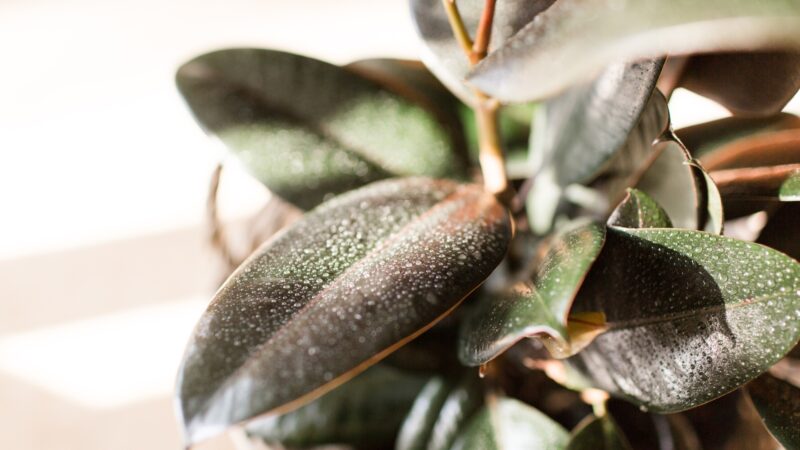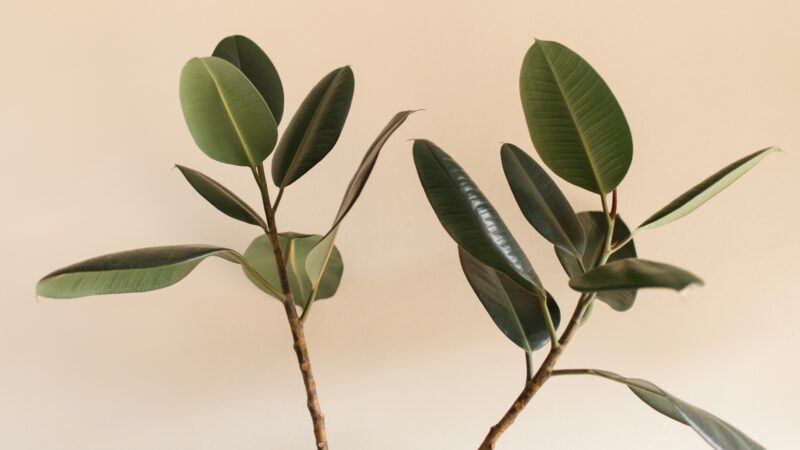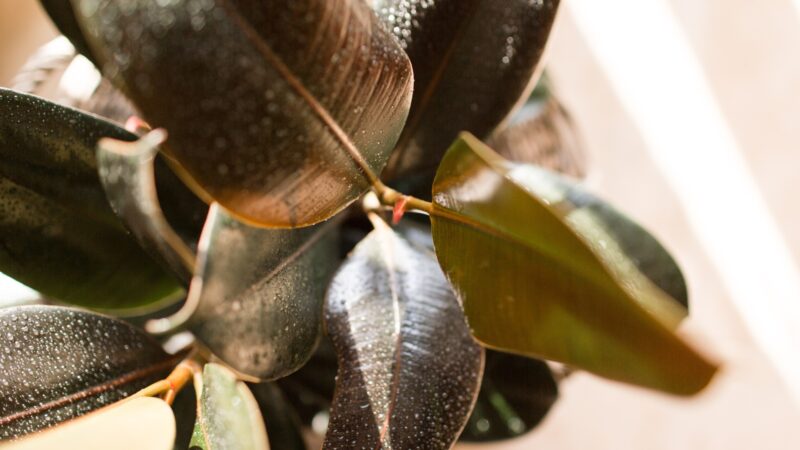Ficus trees, although native to tropical regions, are commonly used as interiors cape plants or houseplants. Ficus burgundy, or rubber plant, is among the most widely propagated ficus species for container culture, making it the ideal tree for both gardening beginners and experts.
To take care of ficus burgundy, plant it in a well-draining soil mix, apply a houseplant fertilizer every two weeks during active growth, then water thoroughly but allow the soil to slightly dry out between waterings. Allow it to receive bright but indirect light and temperatures between 60°F to 80°F. Repot the plant if it becomes rootbound.
This article provides you with everything you need to know about growing and taking care of ficus burgundy. Read further for more interesting information!
What Is Ficus Burgundy?

Prized for its ornamental leaves, ficus burgundy can be grown as an evergreen tree or shrub and is used in patios, shades, screens, and as a specimen tree. It is not commonly used as a street tree since it tends to break apart easily against strong winds. In its native habitat, it can reach 100 feet in height but is often seen at 25 to 40 feet in landscapes.
- Scientific Name: Ficus elastica
- Common Names: Rubber Plant, Rubber Tree, Rubber Fig
- Appearance: Shrub or tree that develops banyan-like aerial roots from its trunks, large, glossy, and leathery dark green leaves, purple to pink stipules, a spreading crown, inconspicuous flowers, and small, oblong-shaped, yellowish-green fruits.
- Origin: Sumatra, Malaysia, Java, and the Himalayas
- Indoor or Outdoor plant: Outdoor (in warmer climates), Indoor (in colder climates)
Is Ficus Burgundy Plants Poisonous?

Ficus burgundy plants are poisonous. Although they are mildly toxic, the milky sap or latex found in their leaves and stems can cause skin and mouth irritation, vomiting, and diarrhea when ingested. As such, they are particularly dangerous to people with latex allergies.
Do Ficus Burgundy Bloom or Produce Fruits?

Ficus burgundy bloom, but it rarely does so when planted indoors. When it is planted in its native habitat, it can produce oblong-shaped fruits, called figs, that are half an inch to quarter an inch in diameter. It is important to note that figs contain flowers inside that are not fragrant or attractive.
How to Take Care of Ficus Burgundy?
Lighting
Ficus burgundy prefers bright but indirect or curtain-filtered light. however, it can adapt to low light conditions. It grows best when provided with the morning light coming from an east window.
Water
Water the plant thoroughly and consistently but let the top 1 to 2 inches of the soil dry out slightly between waterings. Avoid overwatering, as it can kill the lower roots of the plants. Reduce watering during the fall to late winter seasons.
Temperature and Humidity
The ideal day temperatures are between 75°F to 80°F while the ideal night temperatures are between 60°F to 65°F. Rubber plants do not tolerate cold drafts, sudden temperature drops, or temperatures lower than 55°F.
Moreover, they thrive with high relative humidity. To increase the humidity of your plants, place their container on a tray with water and pebbles.
Soil
A commercial well-drained houseplant soil mix can do the trick, but the plant can thrive in nearly any type of soil as long as it is well-draining. You can also try blending in peat moss, vermiculite or perlite, coarse sand, and compost.
Fertilizer
Apply a water-soluble houseplant fertilizer during the spring and summer seasons when the plant is actively growing. Do so every two weeks.
You can also fertilize every two months in the fall and winter seasons. Plants that are grown in low light conditions should be fertilized less often than those planted in bright light.
Potting and Repotting
Containers that can hold the plant upright and won’t distort when the plant grows more roots, such as ceramic, terracotta, and wooden planters, are the most ideal to use. Plastic containers can also be used but make sure they are thick enough to handle the ficus burgundy.
Evergreen trees are usually best repotted during the early spring to late summer seasons, either before the new growth or after old leaves drop. A telltale sign that you should report is when the plant becomes rootbound or when its roots outgrow the volume of its container.
How to Propagate Ficus Burgundy?

By Air Layering
Step 1: Select a branch to the girdle. It should at least be the size of a pencil or larger, and make sure they are shoots produced during the past season.
Step 2: Remove all the bark and the cambium layer (the growing part of the trunk which looks like green tissue), cutting all the way down to the white heartwood of your selected branch.
Step 3: Apply rooting hormone on the cut area, then wrap a handful of moist sphagnum moss or peat moss around it. The moss should be sufficiently moist, like a damp sponge, but not excessively wet.
Step 4: Afterward, wrap the moss with polyethylene film, plastic wrap, or aluminum foil. Make sure to seal the bottom part tightly while the top part is slightly loose using twist ties, electrical tape, or twine.
Step 5: Periodically check on the moss to ensure that it remains moist. Do not let it dry out, as the entire procedure will fail.
Step 6: Over time, roots will begin to emerge at the top of the cut area. Once several are visible, you can cut the rooted stem out of the mother plant and then place it in a pot to let it continue growing as a new, separate plant.
By Stem Cuttings
Step 1: Late winter is the best time to collect stem cuttings from the ficus burgundy since it will be in its dormant stage.
Step 2: Using a sterilized knife or another cutting tool, remove a 4- to 12-inch cutting of the plant, depending on its overall size, and make sure it has at least two nodes. The top cut should be made half an inch to 1 inch above a node, while the bottom cut should be made right below a node.
Step 3: Dip the end of the cutting in rooting hormone and tap any excess if you’re using a powdered formulation.
Step 4: Gather all the stem cuttings together, then tie them using rubber bands or twine. If you’re planning to plant them outdoors, place them in a plastic bag containing wood shavings or slightly moist sphagnum moss, then store them in a refrigerator to prepare for planting.
Step 5: In the early spring season or directly after selecting cuttings, depending on when you plan to root the plants, bury the cuttings up to within an inch or 2 of the top bud. Afterward, provide a constant supply of moisture, especially during dry weather.
How to Prune Ficus Burgundy?
Pruning should be done if the plant becomes too dense, making air penetration more difficult for the plant. Using pruning shears and protective gloves, remove and discard damaged, weak, or dead branches.
Prune branches that are growing downwards or interfering with the growth of other branches. Cut back to about half an inch from the central stem.
How to Make a Burgundy Rubber Plant Bushy?
You can make your plant bushier if you regularly prune it once it grows overly dense.
Common Problems With Ficus Burgundy
| Cause | Symptoms | Solution |
| Anthracnose | Yellow spots on the leaves that appear greasy. | Apply a fungicide to increase the survival rate of the plant and protect it from future pathogens. |
| Bacterial Leaf Spot | Yellow spots are found on the veins that turn brown as well as leaf drop. It can also be circular lesions found on random areas on the leaves. | Avoid watering overhead. Make sure that the roots are soaked and not the foliage. |
| Blight | Young stems and leaves will turn brown to black and develop brown fuzz on their infected tissues. It can also cause leaf drop. | Place plants in a location with higher temperatures. You can also use a heater. Remove any infected tissue immediately. |
| Cold Injury | Mature leaves will develop large, brown blotches while younger leaves will appear distorted, puckered, or turn brown. | Place in a location with a temperature above 40°F. When planting indoors, do not place them near air conditioners. |
| Foliar Nematode | Yellow areas between the leaf veins and leaf death. | Throw away any severely infected plants. For plants that are not extremely affected, remove infected leaves then avoid overhead watering. |
| Root Rot | Caused by having waterlogged soil. The plant will develop brown, irregularly-shaped, soil-like fungal threads. | Make sure to use well-draining soil mixes. Repot your plant to a clean pot if you cannot drain the water inside. Fungicides containing fludioxonil, thiophanate methyl, and flutolanil can also work. |
List of Sources
Rubber plant – https://hgic.clemson.edu/factsheet/rubber-plant/